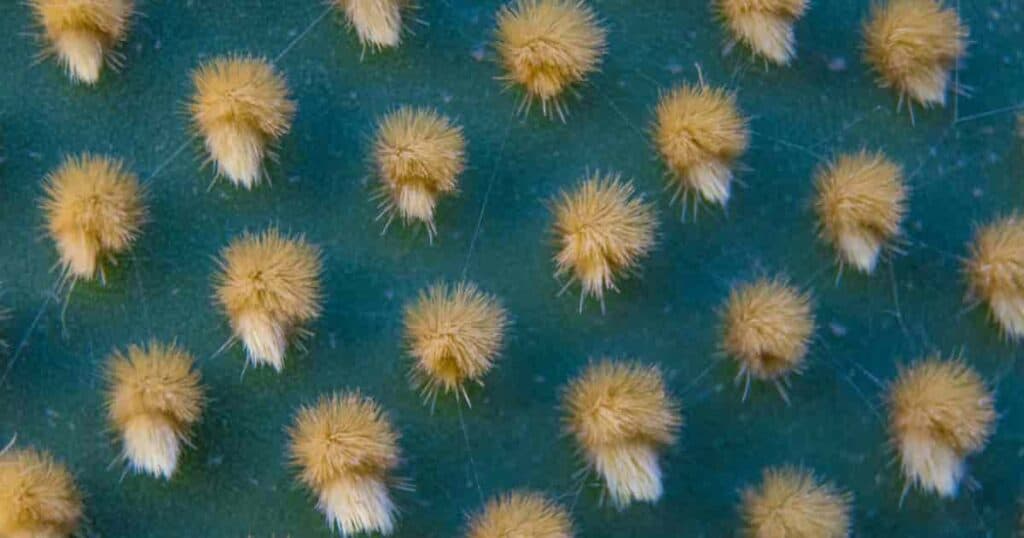When you think of cactus, you naturally think of thorns, but did you know cacti have two types of thorns? Some are the large, sharp, visible spikes you avoid if you simply don’t touch the cactus.

Others are tiny, fine, hair-like, barbed spines growing in tiny whorls on certain types of cactus.
These tiny spines are called glochids or cladodes; you may encounter them even if you don’t touch a cactus.
In this article, we explain what they are, what they do, and how to avoid and deal with them. Read on to learn more.
Only Opuntioideae Cactus Have Glochids
Luckily you will not find these tiny, irritating spines on all cactus.
They only grow on Cholla or Prickly Pear cactus, which are in the Opuntioideae family (Opuntia genus).

Glochids are especially present in the fruit of these plants.
If you look closely, you’ll see them growing in soft-looking tufts around the larger spines, but you won’t see them in this location at all times of the year.

These tiny thorns are deciduous and are very small leaves shading the flesh of the cactus and helping it retain water.
Unfortunately, they also defend the plant with their backward barbed construction acting to repel potential predators with immediate stinging sensations and long-term inflammation and irritation.

If you come in contact with glochids, you’re very likely to pick up several hundred of these tiny, almost invisible barbs at once.
For this reason, prevention is far preferable to cure.
What Can You Do to Avoid Glochids?
Whenever you have to handle one of these plants, you must wear ample protection.

You’ll need the following:
- Eye Protection
- Long Sleeves
- Long Pants
- Garden Gloves
If you must handle cactus in the Opuntia family, it is sometimes helpful to wet the outside of the plant first to wash off any loose glochids and to slick down the ones remaining.

Even so, you’ll need to use proper protection to avoid splinters.
When the fruits of the Cholla cactus are harvested in Jordan, a special tool is used consisting of a long stick with a grasping implement at the end.

Once the fruits are removed from the plant, they are rolled in sand, brushed clean, and then soaked in water before being peeled.
If you do get a clump of glochids embedded in your hand or fingers, resist the natural urge to put the stinging injury in your mouth.
Doing so will just spread the little barbs to your lips, mouth, and tongue.
Keep glochids away from your face, and especially your eyes.
Glochids Can Go Windborne!
It’s important to understand even if you are not handling a Cholla or Prickly Pear plant, you could be affected by glochids.

These tiny, fine hairs can be blown by the wind, so if you are in an area where someone else is harvesting or handling these plants, you could be affected.
It’s this sort of circumstance that often leads to eye injury caused by glochids.
If you get these little barbed, irritating small spines in your eye, serious injury or even blindness could result.

If you get glochids in your eyes, seek medical assistance immediately.
Opuntia Cactus with Glochids:
- Opuntia Microdasys (Bunny Ear Cactus)
- Opuntia Basilaris (Beavertail Cactus)
- Opuntia Humifusa (Eastern Prickly Pear)
What Can You Do If You Get Stuck with Glochids?
If you get glochids stuck in your skin, you’ll notice an immediate itchy, burning, stinging sensation, which will be quickly followed by inflammation.

You are likely to experience discomfort in the tongue, throat, and lips too.
In some people, an allergic reaction causes this to develop into pustules, welts, or blisters.

If you’re not able to get the glochids out of your skin right away, they can cause skin irritation for a very long time (up to nine months).
Luckily there are a few things to get about 95% of the glochids out of your skin; however, getting them all out is next to impossible.

Here are three removal methods:
- Use tweezers and a magnifying glass to pull out as many of the offenders as possible.
- Place duct tape over the affected area and then rip it off.
- Wrap the affected area with gauze and then soak the gauze with white glue.
Allow the glue to dry, and then pull off the gauze.
Using a combination of these most effective methods should remove most of the tiny, barbed irritants.

If you continue to have itching, inflammation, and irritation, the application of ice or a paste made of baking soda and water may help reduce your suffering.
If you are one of the unfortunate people who develop long-standing glochid-induced dermatitis, you’ll need to see your doctor for more aggressive removal of barbs and treatment of symptoms.